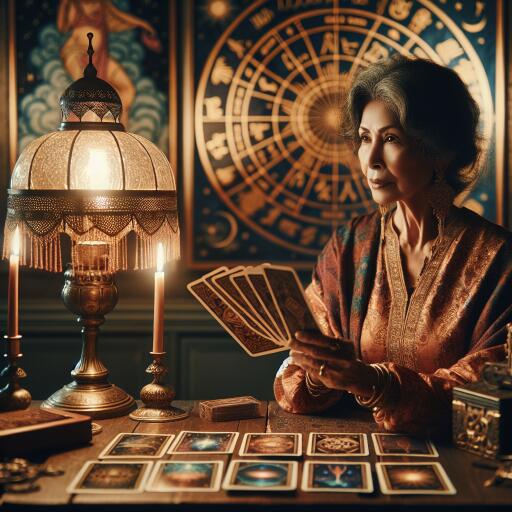Exploring the Numerology of Tarot: Unveiling Connection and Meaning
Among the mystical tools used for divination and personal introspection, Tarot and Numerology stand out for their depth and interconnectivity. At first glance, Tarot, with its rich imagery and symbolism, might appear vastly different from the numerical world of Numerology. However, a closer look reveals a fascinating intertwining, offering enriching insights into one’s life journey, personality, and spiritual path. This article aims to unveil the original and profound connection between Tarot and Numerology, exploring how these ancient practices complement each other, providing a more comprehensive understanding of our experiences and the universe.
The Foundations of Tarot and Numerology
Tarot consists of 78 cards, divided into the Major Arcana (22 cards) and the Minor Arcana (56 cards). Each card possesses its own imagery, symbolism, and story, serving as a mirror to the soul, reflecting our deepest thoughts, feelings, and aspirations. Conversely, Numerology is the study of numbers, believed to hold the key to deciphering the universe’s language, offering insight into an individual’s character, destiny, and life cycles through the numerical value of letters in names, birth dates, and other significant life details.
Numbers in the Tarot
The integration of Numerology within Tarot can be keenly observed through the Major Arcana’s sequencing and the structure of the Minor Arcana. The Major Arcana cards, numbered from 0 (The Fool) to 21 (The World), guide us through the Fool’s journey—an allegory of the human experience, encapsulating life’s cyclical nature and evolutionary path. Each card’s number is imbued with symbolic meaning that deepens its message.
The Minor Arcana, similar to a deck of regular playing cards, is divided into four suits (Cups, Pentacles, Wands, and Swords), each numbered from Ace to Ten, followed by four court cards. The numbers on these cards align with Numerology, offering insight into the energies and lessons they carry. For instance, Aces represent new beginnings, Fours symbolize stability, while Tens indicate completion or culmination.
Discovering the Numerical Depth
To dive deeper into the relationship between Tarot and Numerology, let’s explore the numerology of some key Tarot cards:
- The Magician (1): The number 1 in Numerology signifies initiative, leadership, and the start of new ventures. Similarly, The Magician represents manifestation, resourcefulness, and the power to harness one’s potential, echoing the pioneering spirit of the number 1.
- The High Priestess (2): In Numerology, the number 2 is associated with intuition, balance, and harmony between opposites. The High Priestess embodies these qualities, symbolizing deep intuition, the subconscious mind, and the duality of the material and spiritual worlds.
- Strength (8): The number 8 in Numerology relates to strength, authority, and material success. The Strength card reflects not just physical strength but the inner strength and courage to face obstacles, resonating with the empowering energy of the number 8.
- The Tower (16): To understand cards like The Tower, we add 1+6 to get 7, a number associated with introspection, spiritual awakening, and the quest for truth. The Tower’s destruction symbolizes the breakdown of illusions and the necessity to rebuild on a more authentic foundation, aligning with the transformative essence of the number 7.
Numerology in Practice with Tarot
Incorporating Numerology into Tarot readings can deepen the insight provided by the cards. For instance, calculating the numeric value of a person’s name or birthdate can highlight specific Major Arcana cards that hold particular significance for them, offering a personalized layer to their reading. Similarly, the sum of the day, month, and year of a planned event or question posed during a Tarot reading can point towards relevant energies and potential outcomes.
Furthermore, when multiple cards in a reading share numerical values or sequences, it underscores themes or messages the universe is emphasizing. For example, a spread containing several cards that reduce to the number 4 (such as The Emperor (4), Death (13), and The Tower (16)) may suggest a focus on stability, structure, and the challenges involved in maintaining or rebuilding it.
Conclusion
The interplay between Tarot and Numerology opens up a vast, interconnected cosmos of wisdom and insight, enriching our understanding of ourselves and the universe. By exploring the numerical significance of Tarot cards and incorporating Numerology into our Tarot practices, we can unlock deeper messages, enhance our intuitive capabilities, and navigate our life paths with greater clarity and purpose. As with any mystical or spiritual tool, the key lies in personal exploration, intuition, and the understanding that these ancient practices are here to guide us on our journey to self-discovery and enlightenment.
Whether you’re a seasoned Tarot reader, a Numerology enthusiast, or new to these practices, integrating these realms invites an enriching journey of discovery, offering nuanced perspectives that transcend their individual scopes. As you delve further into the numerology of Tarot, may you uncover layers of wisdom and guidance, illuminating your path with the light of ancient knowledge.


